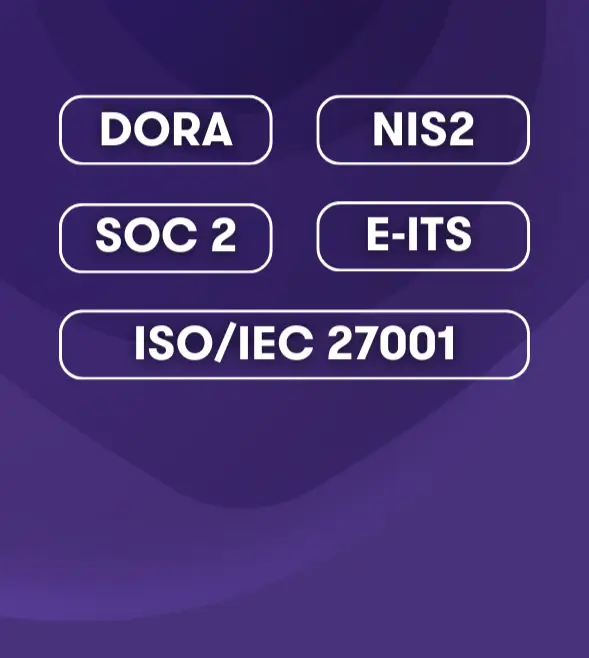-
Other audit services
We help clients with the application and use of foreign financial aid of EU and other funds and help prepare financial reports.
-
Audit calculator
The calculator will answer if the company's sales revenue, assets or number of employees exceed the limit of an inspection or audit.
-
Payroll and related services
We perform payroll accounting for companies whether they employ a few or hundreds of employees.
-
Tax accounting
Grant Thornton Baltic's experienced tax specialists support accountants and offer reasonable and practical solutions.
-
Reporting
We prepare annual reports in a timely manner. We help to prepare management reports and various mandatory reports.
-
Consolidation of financial statements
Our experienced accountants and advisors help you prepare consolidation tables and make the consolidation process more efficient.
-
Consultancy and temporary staff
Our experienced specialists advise on more complex accounting transactions, rectify poor historic accounting, and offer the temporary replacement of an accountant.
-
Outsourced CFO service
Our CFO service is suitable for companies of all sizes and in all industries. We offer services to our clients in the required amount and competences.
-
Assessment of accounting processes
We help companies to implement accounting practices that are in compliance with local and international standards.
-
Accounting services for small businesses
We offer affordable service for small businesses. We help organize processes as smartly and cost-effectively as possible.
-
Cryptocurrency accounting
We keep up with blockchain technology to serve and advise crypto companies. We are supported by a network of colleagues in 130 countries.
-
Trainings and seminars
Our accountants have experience in all matters related to accounting and reporting. We offer our clients professional training according to their needs.

-
Business advisory
We offer legal support to both start-ups and expanding companies, making sure that all legal steps are well thought out in detail.
-
Fintech advisory
Our specialists advise payment institutions, virtual currency service providers and financial institutions.
-
Corporate advisory
We advise on legal, tax and financial matters necessary for better management of the company's legal or organizational structure.
-
Transaction advisory
We provide advice in all aspects of the transaction process.
-
Legal due diligence
We thoroughly analyze the internal documents, legal relations, and business compliance of the company to be merged or acquired.
-
In-house lawyer service
The service is intended for entrepreneurs who are looking for a reliable partner to solve the company's day-to-day legal issues.
-
The contact person service
We offer a contact person service to Estonian companies with a board located abroad.
-
Training
We organize both public trainings and tailor made trainings ordered by clients on current legal and tax issues.
-
Whistleblower channel
At Grant Thornton Baltic, we believe that a well-designed and effective reporting channel is an efficient way of achieving trustworthiness.

-
Business model or strategy renewal
In order to be successful, every company, regardless of the size of the organization, must have a clear strategy, ie know where the whole team is heading.
-
Marketing and brand strategy; creation and updating of the client management system
We support you in updating your marketing and brand strategy and customer management system, so that you can adapt in this time of rapid changes.
-
Coaching and development support
A good organizational culture is like a trump card for a company. We guide you how to collect trump cards!
-
Digital services
Today, the question is not whether to digitize, but how to do it. We help you develop and implement smart digital solutions.
-
Sales organisation development
Our mission is to improve our customers' business results by choosing the right focuses and providing a clear and systematic path to a solution.
-
Business plan development
A good business plan is a guide and management tool for an entrepreneur, a source of information for financial institutions and potential investors to make financial decisions.
-
Due diligence
We perform due diligence so that investors can get a thorough overview of the company before the planned purchase transaction.
-
Mergers and acquisitions
We provide advice in all aspects of the transaction process.
-
Valuation services
We estimate the company's market value, asset value and other asset groups based on internationally accepted methodology.
-
Forensic expert services
Our experienced, nationally recognized forensic experts provide assessments in the economic and financial field.
-
Business plans and financial forecasts
The lack of planning and control of cash resources is the reason often given for the failure of many businesses. We help you prepare proper forecasts to reduce business risks.
-
Outsourced CFO service
Our CFO service is suitable for companies of all sizes and in all industries. We offer services to our clients in the required amount and competences.
-
Reorganization
Our experienced reorganizers offer ways to overcome the company's economic difficulties and restore liquidity in order to manage sustainably in the future.
-
Restructuring and reorganisation
We offer individual complete solutions for reorganizing the structure of companies.
-
Corporate taxation
We advise on all matters related to corporate taxation.
-
Value added tax and other indirect taxes
We have extensive knowledge in the field of VAT, excise duties and customs, both on the national and international level.
-
International taxation
We advise on foreign tax systems and international tax regulations, including the requirements of cross-border reporting.
-
Transfer pricing
We help plan and document all aspects of a company's transfer pricing strategy.
-
Taxation of transactions
We plan the tax consequences of a company's acquisition, transfer, refinancing, restructuring, and listing of bonds or shares.
-
Taxation of employees in cross-border operations
An employee of an Estonian company abroad and an employee of a foreign company in Estonia - we advise on tax rules.
-
Tax risk audit
We perform a risk audit that helps diagnose and limit tax risks and optimize tax obligations.
-
Representing the client in Tax Board
We prevent tax problems and ensure smooth communication with the Tax and Customs Board.
-
Taxation of private individuals
We advise individuals on personal income taxation issues and, represent the client in communication with the Tax and Customs Board.
-
Pan-Baltic tax system comparison
Our tax specialists have prepared a comparison of the tax systems of the Baltic countries regarding the taxation of companies and individuals.
-
Internal audit
We assist you in performing the internal audit function, performing internal audits and advisory work, evaluating governance, and conducting training.
-
Internal Audit in the Financial Services Sector
We provide internal audit services to financial sector companies. We can support the creation of an internal audit function already when applying for a sectoral activity license.
-
Audit of projects
We conduct audits of projects that have received European Union funds, state aid, foreign aid, or other grants.
-
Prevention of money laundering
We help to prepare a money laundering risk assessment and efficient anti-money laundering procedures, conduct internal audits and training.
-
Risk assessment and risk management
We advise you on conducting a risk assessment and setting up a risk management system.
-
Custom tasks
At the request of the client, we perform audits, inspections and analyzes with a specific purpose and scope.
-
External Quality Assessment of the Internal Audit Activity
We conduct an external evaluation of the quality of the internal audit or provide independent assurance on the self-assessment.
-
Whistleblowing and reporting misconduct
We can help build the whistleblowing system, from implementation, internal repairs and staff training to the creation of a reporting channel and case management.
-
Information security management
We provide you with an information security management service that will optimise resources, give you an overview of the security situation and ensure compliance with the legislation and standards.
-
Information security roadmap
We analyse your organisation to understand which standards or regulations apply to your activities, identify any gaps and make proposals to fix them.
-
Internal audit of information security
Our specialists help detect and correct information security deficiencies by verifying an organization's compliance with legislation and standards.
-
Third party management
Our specialists help reduce the risks associated with using services provided by third parties.
-
Information security training
We offer various training and awareness building programmes to ensure that all parties are well aware of the information security requirements, their responsibilities when choosing a service provider and their potential risks.
-
Digital Operational Resilience Act (DORA)
We will help you create a DORA implementation model that meets your company's needs and ensures that you meet the January 2025 deadline.

-
ESG advisory
We help solve issues related to the environment, social capital, employees, business model and good management practices.
-
ESG audit
Our auditors review and certify sustainability reports in line with international standards.
-
Sustainable investments
We help investors conduct analysis of companies they’re interested in, examining environmental topics, corporate social responsibility and good governance practices.
-
Sustainable tax behaviour
Our international taxation specialists define the concept of sustainable tax behaviour and offer services for sustainable tax practices.
-
ESG manager service
Your company doesn’t necessarily need an in-house ESG manager. This role can also be outsourced as a service.

-
Recruitment services – personnel search
We help fill positions in your company with competent and dedicated employees who help realize the company's strategic goals.
-
Recruitment support services
Support services help to determine whether the candidates match the company's expectations. The most used support services are candidate testing and evaluation.
-
Implementation of human resource management processes
We either assume a full control of the launch of processes related to HR management, or we are a supportive advisory partner for the HR manager.
-
Audit of HR management processes
We map the HR management processes and provide an overview of how to assess the health of the organization from the HR management perspective.
-
HR Documentation and Operating Model Advisory Services work
We support companies in setting up HR documentation and operational processes with a necessary quality.
-
Employee Surveys
We help to carry out goal-oriented and high-quality employee surveys. We analyse the results, make reports, and draw conclusions.
-
HR Management outsourcing
We offer both temporary and permanent/long-term HR manager services to companies.

-
Digital strategy
We help assess the digital maturity of your organization, create a strategy that matches your needs and capabilities, and develop key metrics.
-
Intelligent automation
We aid you in determining your business’ needs and opportunities, as well as model the business processes to provide the best user experience and efficiency.
-
Business Intelligence
Our team of experienced business analysts will help you get a grip on your data by mapping and structuring all the data available.
-
Cybersecurity
A proactive cyber strategy delivers you peace of mind, allowing you to focus on realising your company’s growth potential.
-
Innovation as a Service
On average, one in four projects fails and one in two needs changes. We help manage the innovation of your company's digital solutions!


It is currently a golden era for fraud but harm caused by bad actors is preventable if you regularly perform checks on business partners and clients and keep alert to specific warning signs, panellists on the Äripäev business daily radio programme “Kasvukursil” said.
“It is now a time where business decisions are made based on old reports,” said Grant Thornton Baltic partner and Head of Audit Mart Nõmper. He mentioned the fact that the deadline for annual reports is the last day of June, and thus anyone checking a company’s background may have to content themselves with 2021 – fairly old – reports. “So it’s a golden time for fraud.”
Still, regular checks of one’s partner help stave off falling victim to fraud. “Vigilance is the norm in the phase where business relationships are established, but life shows that major credit losses are sustained from long-time clients, because as time passes, companies let their guard down about checking them,” said Nõmper.
CEO of Creditinfo Eesti Elari Tammenurm added that the changing world dictates the need for constant checks. “A company with whom cooperation was launched two years ago may have had strong financials at the start but they may have shed partners, developed problems paying invoices.”
Tammenurm adds that if red flags come up in the course of regular checks, they should be addressed even if the existing relationship with the client is , impeccable. “I know an example where a partner with a suspicious background rented a car five times from a company and always returned it in order but the sixth time the car was stolen and transported across a border."
Certain danger signs
Red flags that call for caution in regard to a partner are many and experts say they should be viewed in amalgamated form. ”You may have a wonderful, active and solvent client but if a management board member is never able to take part in a meeting, colleagues say he or she is constantly travelling on business and can’t be reached even by Teams…it’s not beyond the realm of possibility that the person might be in jail,” said the head of Grant Thornton Baltic’s support unit, Diana Varik.
Another red flag according to Varik is if the client does not want to share information about their structure or ultimate actual beneficial owners. It is also a danger sign if the changes to the management board are too frequent.
For example, after the Ukraine war, some companies started making changes to management board members to dodge sanctions. Some players on the market also offer company founding service to foreign nationals. Founding and selling a company is completely legal but the buyer may not always be as clean as the seller,” she said.
Tammenurm adds payment problems and tax debts to the list of red flags. “It’s also worth checking the media image of the partner, whether any court decisions are in force and whether they submit annual reports regularly.”
Varik said it is also important to ask about the partner’s cash or cryptocurrency transactions. The Financial Intelligence Unit and banks also keep an eye on this and ask about movement of invoices,” said the expert.
Nõmper said companies’ trustworthiness is higher if the financial reporting has been audited. “I don’t want to say that unaudited data are always flawed but the risk is just higher. It’s worth remembering that it’s possible to voluntarily order an audit to be trustworthy in the eyes of counterparties to a transaction.”
Higher standards
There was consensus among the experts that as time goes on, the higher the standards that one’s business partners are subjected to. “This holds true for property relationships in particular. In the past, it seemed OK when you got paid, but the origin and background of funds were not of that interest but since February 2022 the reputation damage from not being aware of who the ultimate beneficial owners are can be significant,” said Tammenurm regarding money laundering risks and the risk of doing business with partners subject to sanctions.
In addition to sanctions, more attention is being paid to whether the business partner follows ESG principles. “Many companies include in their ESG policy what persons they won’t work with and define who did not meet their values,” said Nõmper. “A transaction may look legal but it may not align with values.”
Follow the rules you set for yourself
Nõmper added that once the rules the client must meet are in place, they must be followed and no exceptions granted. “As an auditor I can say that the ones who have sustained fewer credit losses are systematic and adhere to the established precautionary measures.”
He added that if things go south, a quick reaction time is important. “Whoever leaves the table has to pick up the tab for the party,” he warned. “The one who leaves first sustains less losses.”
From the perspective of Grant Thornton Baltic, the experts noted that the existence of a red flag does not always necessarily rule out a client but a higher risk means accepting a higher price. “We take all warning signs into consideration when setting prices. The more careful we have to be and the more resources we spend, the higher the price is,” said Nõmper.
To sum up, Tammenurm recommends relying on experts and websites that specialize in assessing business partner risk. They have gathered all the red flags together and have arrived at risk scores.
“Instead of taking a long list of databases and starting to assess influences, the score solutions devised on the market can be used, where all indicators are aggregated into a single value. Yes, Google is free, but time also costs something.”
If you have similar challenges and questions, please contact our specialists.









